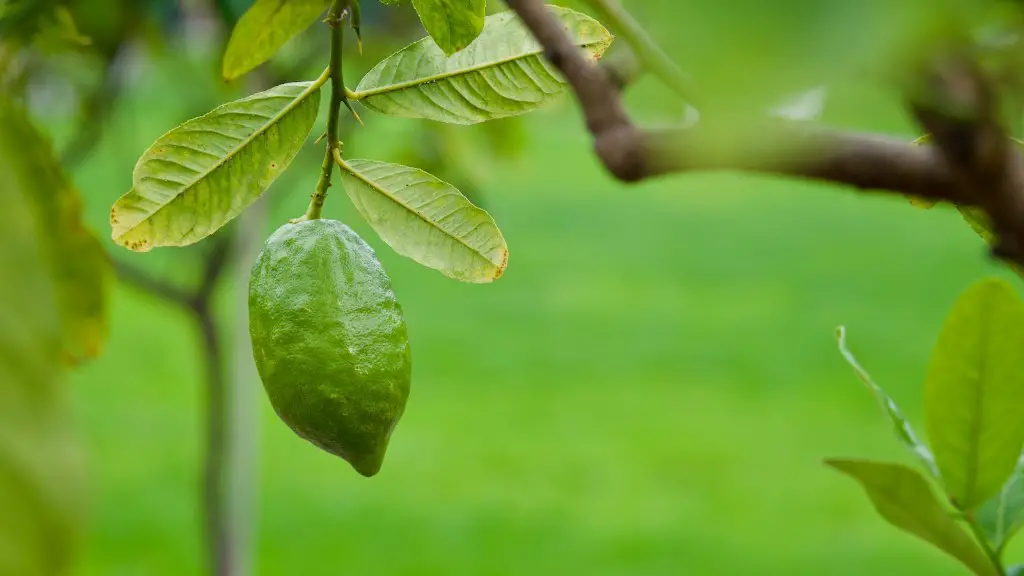Gall wasp can, in fact, affect lemon trees, though it is not as common for such trees to be affected as it is for other types of trees. The wasp does this by injecting its eggs and larvae into the tree’s bark and stems, causing the tree to grow galls, which appear as rough, tumor-like growths on the branches and trunks. These galls are created in order to give the larvae protection and provide a food source in the form of the tree’s sap. Gall wasps can cause considerable damage to a lemon tree, eventually leading to it’s death.
Gall wasps can be particularly difficult to eliminate since they can affect multiple species of trees, as well as multiple parts of the same tree. They are difficult to detect since they usually lay their eggs and larvae in hard-to-reach places, such as in the tree’s bark or in the crevices of branches. Furthermore, their larvae can remain in the galls they create, hibernating until favorable conditions arise.
Given the potential damage caused by gall wasps to a lemon tree, it is important to take necessary steps to prevent them from afflicting it. One way of doing so is to regularly clean up any dead branches or twigs in or around the tree. This will help reduce the number of places where wasps can lay their eggs, in turn reducing the possibility of the tree becoming infected. Additionally, it is also important to ensure that the tree receives proper care and attention by providing it with adequate water, nutrition, and protection from pest and disease. Regular inspection will also help identify and eliminate any signs of gall wasp infestation.
In some cases, chemical methods can be used to eliminate gall wasps. Nonetheless, these methods should be considered only as a last resort as they can be dangerous for both the tree and the environment. Additionally, it is recommended that before using any type of chemical treatment, advice from an expert should be sought to ensure that the treatment is both effective and safe.
In conclusion, gall wasps can indeed affect lemon trees, and preventive measures should be taken to protect them from infestation. If a tree is infested, chemical treatments should be considered only as a last resort, and an expert should be consulted for advice before using any such methods.
Signs of Gall Wasp Infestation
Gall wasps can be difficult to detect, however there are certain signs which may point to the presence of infestation. These include the presence of galls, as well as yellowing leaves, wilting, and premature defoliation. Additionally, the presence of sawdust-like frass at the base of a tree may indicate that there are larvae present inside the galls.
Inspection of the tree is essential in order to identify any signs of gall wasp infestation. Any galls should be checked for the presence of sawdust-like frass, and the undersides of the leaves should also be checked for this frass. Furthermore, a detailed inspection of the tree’s bark, branches, and stems should also be carried out in order to detect any signs of larvae.
Once infestation is identified, it is important to take the necessary steps to eliminate the wasps. Removing the infected and dead branches should be the first step, in order to prevent the spread of the infestation and reduce the number of places where the wasps can lay their eggs. Additionally, the tree should be treated with a suitable insecticide, and if the infestation is particularly severe, a chemical such as an insecticidal soap can be used.
Gall wasps can affect lemon trees, but with the right knowledge and preventive measures, it is possible to reduce the risk of infestation. Proper inspection, cleaning up, and with the help of an insecticide, the tree can be protected from being damaged or killed by the wasps.
Physical Damage Caused by Gall Wasp Infestation
Gall wasp infestations can cause considerable physical damage to a lemon tree, which can eventually lead to its death. Infestation can result in deformity of the growth points, stunting of the tree, and a decrease in productivity. Additionally, the galls created by the larvae can hinder the tree’s ability to take up nutrients, leading to yellowing leaves, wilting, and defoliation.
The galls themselves can damage the structure of the tree, leading to decay and eventual death of the branches. Furthermore, they can also provide avenues of entry for other disease-causing agents and pests, leading to further damage.
It is important to tackle any gall wasp infestation as soon as possible in order to reduce the damage to the tree. The previously mentioned methods, such as cleaning up and treating the tree with an appropriate insecticide, should be taken in order to eliminate the wasp and reduce the amount of damage caused.
For particularly severe infestations, it may be necessary to remove the infected tree in order to prevent the spread of infestation to other healthy trees. This should be done with the help of a professional who can properly dispose of the tree in a safe manner.
The physical damage caused by gall wasp infestations can be considerable and can lead to the death of a lemon tree. Therefore, it is important to identify and eliminate the infestation as quickly as possible in order to protect the tree and reduce the damage.
Biological Control Methods For Gall Wasp Infestation
Biological control methods, such as the use of natural enemies, can be used as an alternative to chemical treatments in order to control gall wasp infestations of lemon trees.
These natural enemies include predatory wasps, beetles, and other insects which parasitize the larvae, as well as fungicides, which can be used to kill the wasps and larvae. Additionally, certain bacteria and viruses can also be used to control the infestation.
The use of natural enemies can be combined with other methods such as the removal of infected branches and the use of insecticides in order to reduce the infestation. Furthermore, the natural enemies can help reduce the number of insects in the vicinity of the tree, which can aid in the prevention of further infestation.
The use of natural enemies can also be beneficial in terms of reducing the amount of chemical pollution in the environment, since these methods do not involve the use of hazardous chemicals. Additionally, they can also be less expensive than chemical treatments, as well as less labor-intensive.
Biological control methods can offer a viable alternative to chemical treatments in the control of gall wasp infestations in lemon trees. These methods can be more environmentally friendly, less expensive, and less labor-intensive, as well as more effective in containing and reducing infestations.
Preventative Measures To Avoid Gall Wasp Infestation
Preventative measures are essential in order to reduce the chance of lemon trees becoming infested with gall wasps. The most important one is to ensure that the tree receives proper care and attention, such as adequate water and nutrition, as a healthy tree is less likely to become infested with pests and disease.
Additionally, regular inspection of the tree is essential in order to identify any signs of infestation, such as the presence of sawdust-like frass or galls. It is also important to clean up any dead branches or twigs around the tree, as these provide a suitable habitat for gall wasps.
Finally, the use of insecticides should be considered, particularly in cases of heavy infestation. However, this should be done with caution, as chemical treatments can be dangerous for both the tree and the environment, and it is recommended to seek advice from an expert before using them.
To sum up, gall wasps can affect lemon trees, leading to considerable damage, and even death. Therefore, preventive measures should be taken in order to reduce the risk of infestation, such as providing the tree with proper care, regularly inspecting it, and cleaning up dead branches or twigs. Chemical methods should only be used as a last resort, and should be approached with caution.




